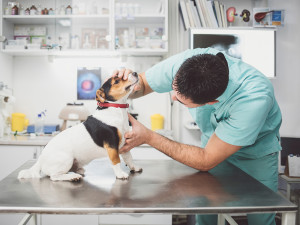Staying On Top of Canine Melanoma
Dog melanoma can develop in many places on a dog’s body. Here’s everything you need to know about what causes melanoma and its symptoms

share article
There’s nothing better than petting a fluffy dog, even if they’re shedding all over your clothes. Very few of us think about what’s underneath all that delightful soft fur: their skin. But your dog’s skin can be key to keeping them in good health, especially as they age.
Melanoma (a type of skin cancer) is one of the most frequently diagnosed cancers in dogs and can develop in many places on a dog’s body. The only good news about a dog having melanoma is that when you know what to look out for, you have a much better chance of catching it early enough to treat. Melanoma isn’t always found on the surface, and where it’s located may change how it’s treated. Read below for some understanding of melanoma in dogs and how you can be proactive to keep your dog healthy and happy.
What is melanoma in dogs?
Melanoma in dogs starts in pigment cells on the skin, in the mouth, the nail bed of the toes, footpads or even in the eye. Humans also get melanomas, usually from too much sun (wear sun cream, folks), but that’s not what bothers dogs. Dogs with dark coats and darkly pigmented skin have more of a chance of developing melanomas, whereas lighter shades of pups are much less affected on the skin.
Oral melanoma (OMM) is the most common form of all these melanomas, and routine exams by a pet parent can often catch them on the dog’s gums, lips, tongue or hard palate – the spot just above their tongue.
Signs and symptoms to look out for
If you’re peeping inside your dog’s mouth or checking them for ticks, look for any dark raised mass, too. That’s not the only way melanoma in dogs presents but is the most common. Not every dog with melanoma has other symptoms. However, your pup should be looked at by a veterinarian if you notice your dog suddenly:
drooling
has stinky breath that they didn’t before
has difficulty eating
bleeding in their mouth
For the toenail or footpad, there might be swelling, or the nail could become loose when they have melanoma. If you notice your dog limping or having trouble walking, that’s also a sign a melanoma could be developing. The ones in the mouth and nail bed are the most aggressive, so don’t delay getting them checked out.
How is melanoma in dogs diagnosed?
Vets perform something called an aspiration on the suspected melanoma sight, using a fine needle to get a sample. This is generally more affordable than a biopsy, though some vets will just go for the latter to be sure right away. Further testing usually helps figure out what stage the cancer is, and those could include blood and urine samples, an assessment of nearby lymph nodes, an X-ray, or a CT scan of the chest.
Dog breeds predisposed to melanoma
Any dog can develop melanoma, but there are breeds who are more predisposed, including Cocker Spaniels, Chow Chows, Scottish Terriers, black Labs, black Poodles, Golden Retrievers, Dachshunds, Dobermans, and Standard and Miniature Schnauzers.
How is melanoma in dogs treated?
There is bad news, which is that often, by the time a melanoma is recognised, it has a good chance of having metastasised and spread to other parts of the dog’s body. In most cases, following the surgical removal of melanoma, metastatic tumours in the lungs appear after a period of months. OMM is particularly quick to spread. Here’s how vets try to tackle this problematic skin cancer.
Surgery
The first and best treatment is usually surgery, no matter where the melanoma is located. The vet will want to eliminate the primary tumour as best they can before using radiation or immunotherapy to slow down its spread.
Dogs are very adaptive, so those who have to have more major oral surgery, including the removal of an upper or lower jaw bone, have pretty good functional outcomes – some learn how to eat as early as three days after surgery.
Radiation
Sometimes a melanoma’s location rules out the surgery, so radiation or immunotherapy may be used on their own. Because melanoma tends to be unresponsive to it, chemotherapy is rarely part of the treatment protocol.
Radiation usually involves three to six treatments delivered daily or weekly; higher-than-standard doses seem to provide a better response.
Susan Tasaki
Freelance writer Susan Tasaki lives in the San Francisco Bay Area with her Husky, who wishes they both got out more.





